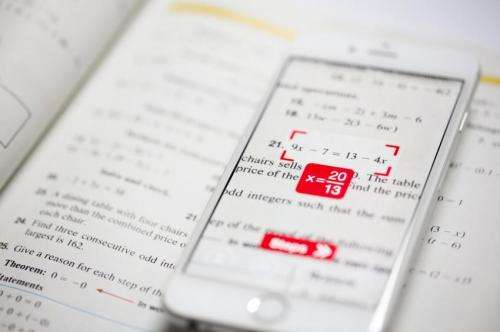October 22, 2014 weblog
Blink, point, solve an equation: Introducing PhotoMath

"Ma, can I go now? My phone did my homework." PhotoMath, from the software development company MicroBlink, will make the student's phone do math homework. Just point the camera towards the mathematical expression, and PhotoMath displays a result. The PhotoMath app solves equations using the camera on an iOS or Windows phone and will be available for Android early next year. More important, PhotoMath is not just a camera-based calculator. Its value is not just in giving the phone user the answer but in being able to display the solution in steps taken to solve the problem. The user can understand the process that was used to solve the problem.
Supported features are arithmetic expressions, powers and roots, fractions and decimals and simple linear equations "and constantly adding new." The Windows Phone store app included a Note: "PhotoMath does not use magical powers, so please do not expect it will solve every equation. If it happens that some equation is not solved, please use the feedback button which will send the last image to us. Our developers will try to do their best to improve PhotoMath."
The team launched the app at TechCrunch Disrupt Europe in London, which took place from October 20-21. A promotional video shows how PhotoMath scans a math problem from a physical textbook and solves it real-time. "We are not an educational company," co-founder and CEO Damir Sabol told TechCrunch. PhotoMath is helping them promote their core technology focus, mobile machine vision.
"The startup is in the business of selling its core technology to companies who might find it useful," said TechCrunch. The group said it would welcome development companies or system integrators who would like to integrate the products for their clients. The company offers a real-time camera text recognition SDK for mobile apps; an ID card, driver license and passport scanning SDK; payment data scanning SDK for mobile banking apps; and a barcode scanning SDK. In creating algorithms for mobile devices, they earlier on developed PhotoPay to scan payment slips and used the technology to build PhotoMath, which, they said, goes further when it comes to accuracy and speed, and showcases the group's technology. They use video frames and combine the OCR results of consecutive video frames.
Interestingly, the introduction of their product has drawn reactions from former math students who remember their school experiences and they reveal frustration in math classroom teaching practice that is short on practical real-life examples. One comment was negative over the very idea of an instant answer source, and they would not recommend this mobile math solution for students. Other reactions argued that the ability to get an answer quickly or not quickly was not the issue; at issue should be how math is taught in schools, where some teachers want the correct answer, a show of how the answer was achieved, and end of story. That, they said, should not be the end of story. "Having an applicable connection makes it easier to learn and understand." Another comment was that "If only high school students had an opportunity to apply their polynomial-solving skills to real-world applications...they would appreciate why they have to learn these skills in the first place."
More information:
photomath.net/
vimeo.com/109405701
© 2014 Tech Xplore





















